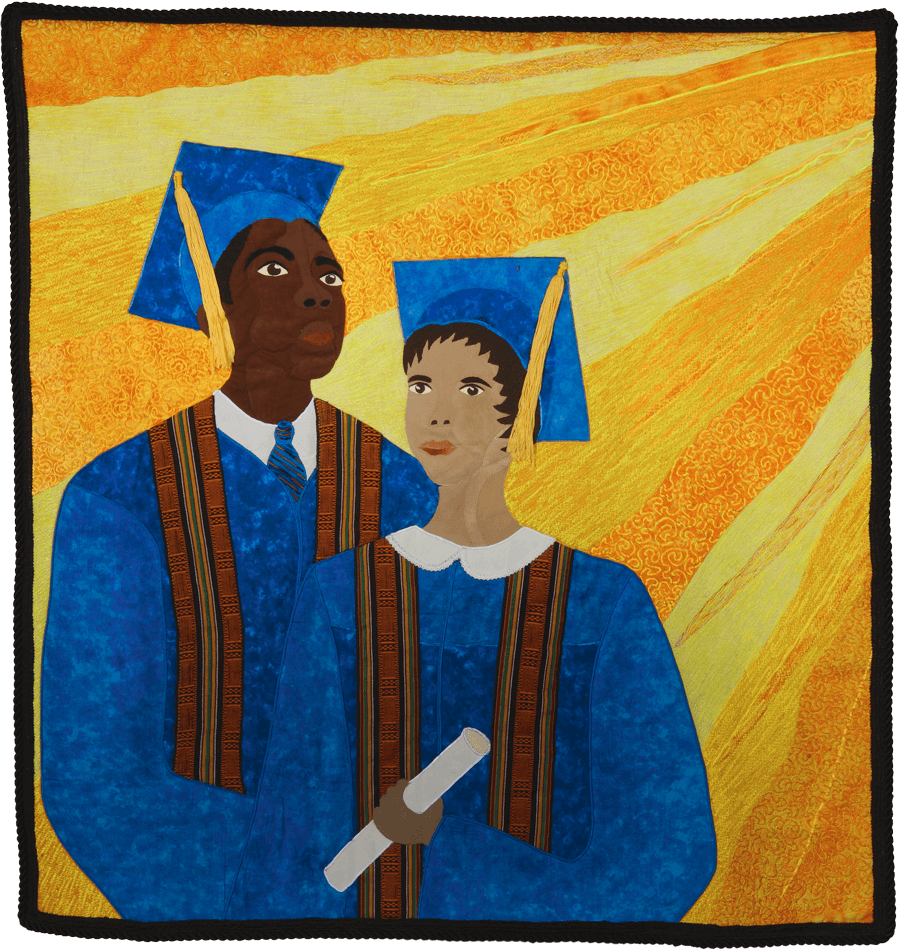“Open Hands: Crafting the Spiritual” Gallery Guide
Learn More About the Artists and Works Featured in Open Hands: Crafting the Spiritual
Open Hands: Crafting the Spiritual assembles the work of six intergenerational artists from across the country who use everyday materials, found objects, and elements of craft production to explore issues related to faith and spirituality, personal and cultural identity, and tradition and community. Included here are artworks made from clay, fiber, fabric, photographs, paper and ephemeral materials such as tin foil. The materials and techniques used reveal the close connections each artist has to the objects they make. Yet, the creative process transforms these highly personal expressions into artworks that speak to people of diverse backgrounds, inviting experiences of joy, connection, and community.
Artworks on view represent a range of religious practices and faith traditions while
broadly focusing on history, social justice and personal identity. The connections
to folk art and craft production take the works out of the often-rarified world of
museums and galleries and open the art to audiences of all backgrounds and experiences.
The democratic spirit pervasive in this work allows for readings on multiple levels
rather than offering a single interpretation.
The artistic practice of these six individuals is only a sampling of what is emerging
from artists’ studios in this country and worldwide. Whether drawing on personal meditation
or organized religion, inspiration comes from a place of spirituality and reflection
that manifests itself in a crafted form. And while culture moves further and further
into the digital realm, it remains critical that artists open their hands and continue
to use them as art-making tools.
Click on a heading for the full content
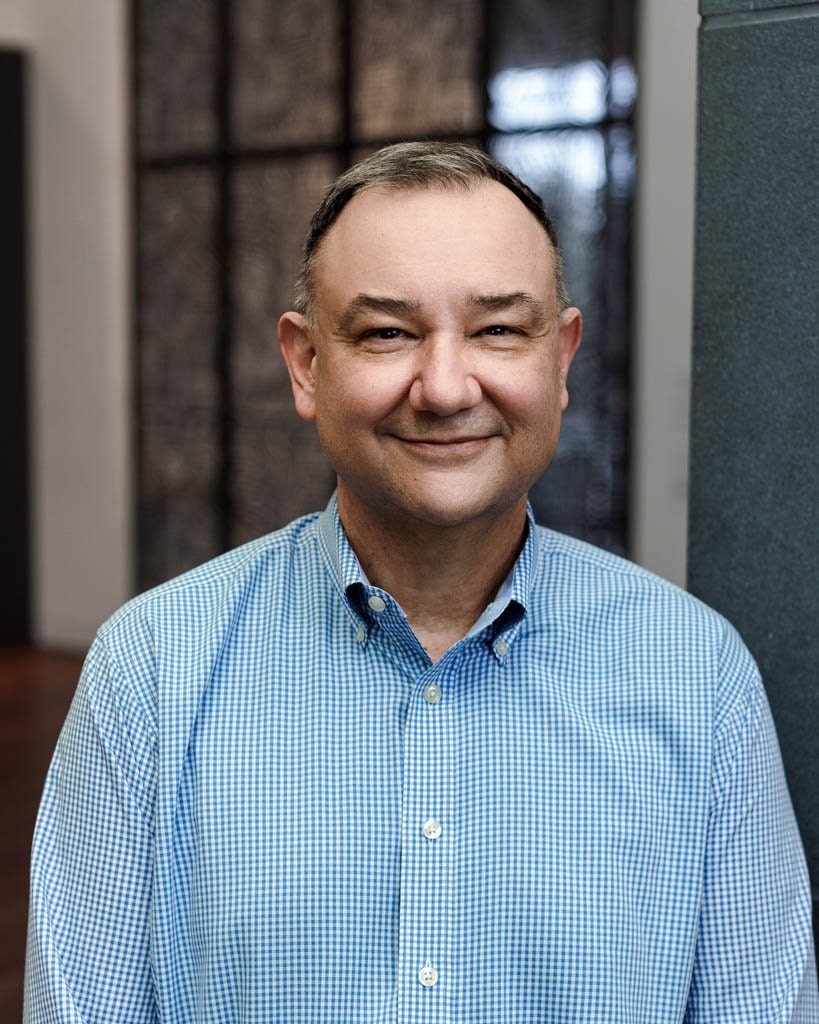
René Paul Barilleaux has been a curator for 40 years, focusing especially on the work of artists outside the mainstream or at mid- and late-career. Since 2005, he has led the curatorial department at the McNay Art Museum in San Antonio, where he is head of curatorial affairs. With a background in studio practice, Barilleaux’s curatorial interests lie in incorporating innovative presentation techniques to engage audiences in challenging and unexpected ways. Early years at the Museum of Holography in New York thrust him into the world of alternative and non-traditional institutions. Since then, his exhibitions and publications have won awards, including an AAMC Award of Excellence in 2020 for Transamerica/n: Gender, Identity, Appearance Today. Barilleaux’s curatorial approach is collaborative and allows diverse voices to construct an open and welcoming narrative for the public. A native of Lafayette, Louisiana, Barilleaux shares his life with his husband, Tim Hedgepeth, and their dog, Lucy.
In September 2022, Barilleaux participated in a MOCRA panel discussion titled “Artist, Poet, Curator.”
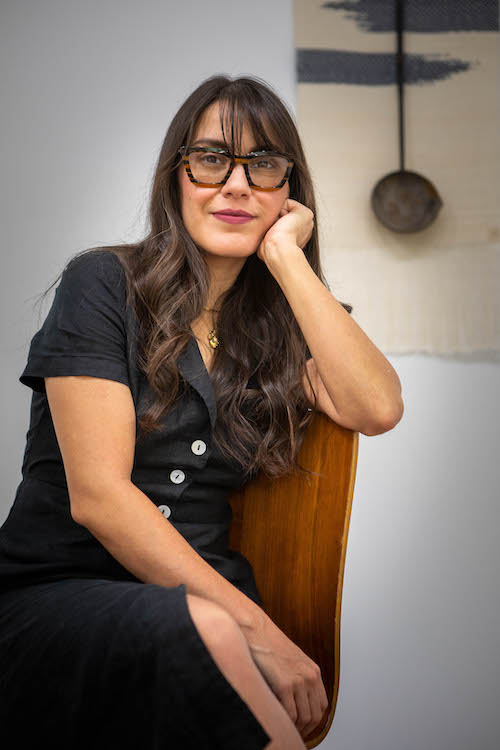
Jenelle Esparza was born in 1985 in Corpus Christi, Texas. She received a Bachelor of Fine Arts degree from the University of Texas at San Antonio in 2010. Her art has been exhibited nationally and she has received numerous honors, including an artist grant from the National Association of Latino Arts and Culture in 2015 and a residency at Artpace in San Antonio in 2018. In addition to her studio practice, Esparza is head of education at the McNay Art Museum in San Antonio, where the artist also resides. Photo of the artist by Jayme Kaye Gershen
About the Work
Texas native Jenelle Esparza draws inspiration from the history, landscape, and blending of cultures found in South Texas and along the United States/Mexico border. Her photographs, textile works, and sculptural assemblages make abstract and metaphorical references to migration, dislocation, tradition, and home. This presentation includes an example of her Landscape Tapestry works. Here, rosaries are entwined within a metal fence reminiscent of those found along the Texas border.
Cotton is personally and historically significant to Esparza. The interconnective qualities of cotton make it a root source material for her. It represents a more extensive global history that her family is connected to through their lineage, picking cotton in south Texas fields for generations. Esparza talks about these connections in the following videos.
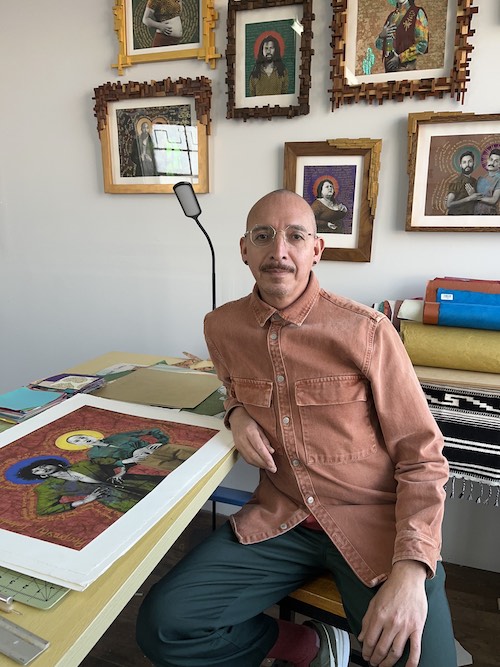
Gabriel Garcia Roman was born in 1973 in Zacatecas, Mexico, and raised in Chicago. He received a Bachelor of Arts degree from the City College of New York in 2012. Garcia Roman works in a range of media and creates images and objects that explore identity. He received an artist grant from the National Association of Latino Arts and Culture in 2018. A year later, the artist was commissioned to present 100 Queer Icon flags as part of the World Pride march. His art has been widely exhibited over the past years. Garcia Roman lives in New York. Photo courtesy of the artist
About the Work
Portraits by Gabriel Garcia Roman, notably his Queer Icons series, give visibility to underrepresented populations and draw inspiration from historical portraiture. The artist sees these individuals as heroes and honors them accordingly. Elements of traditional icons are merged with photographs and text — authored by the portrait’s subject — to offer broader insight into each person’s personal story. Custom framing completes the portrait’s formal presentation. Here, two of Garcia Roman’s portraits are presented as banners or flags that were used in a public march.
Garcia Roman notes, “The subjects in the series are drawn from many facets of the gender and queer spectrum, and these images give visibility to a population that’s generally under-represented in the art world. Finding inspiration in portraiture styles of Renaissance, Flemish and Christian Orthodox paintings, the series aims to elevate these multi-dimensional, powerful and proud contemporary figures. “
Garcia Roman makes extensive use of the techniques of photogravure and chine-collé.
Photogravure involves using a photograph or negative to etch an image into a copper plate with
light and chemicals, then printing it traditionally with ink on paper. Learn more about the photogravure process.
Chine-collé is a special printmaking technique in which paper of a different color or texture
is layered between the printing plate and printing paper. The chine-collé is bonded
to the printing paper during the printing process, and is integral to the print. Learn more about the printing process.
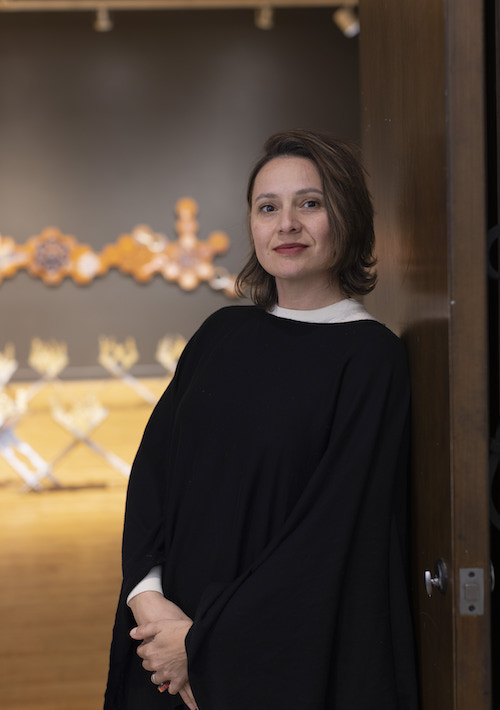
Beliz Iristay was born in 1979 in Izmir, Turkey. She currently lives between Ensenada, Mexico, and San Diego. She received a Bachelor of Fine Arts degree from Dokuz Eylul University in 2003. Iristay creates sculptures and installations, often in clay. Her art examines tradition, identity, gender, and custom, with a particular emphasis on spaces “in-between.” Her work has been exhibited nationally and internationally, including Slovenia, Mexico and Turkey, in addition to the United States. She had a solo exhibition at the Riverside Art Museum in California in 2023, and in 2021 Iristay received a San Diego Art Prize. Photo of the artist by Zeynep Dogu
About the Work
Beliz Iristay creates installations and sculptures that reference the culture and traditions of her native Turkey while exploring contemporary themes and issues. Iristay is known especially for her ceramic work. Stylized designs, calligraphy, and motifs found in historic decoration are incorporated to give new meaning to both traditional embellishment and current artistic practice. Here, a Quran holder and small minarets are found in Memento while references to Islam are noted in Where is He?
Art historian Lauren Lockhart writes, “As a Turkish-American whose personal and professional life straddles the border
between Mexico and the United States, Iristay’s work is grounded in her identity as
an immigrant. She enjoys what she describes as the ‘bilateral view of an outsider.’”
Iristay combines materials and techniques that originate from her different cultures.
She has noted, “Brick is Mexican, patterns are Turkish, and when you immigrate, the cast brick
form is always heavy in every sense of the word. The cast adobe bricks evoke the immigrants’
baggage, as well as the walls—both literal and metaphorical—that they encounter along
their journey. They are a manifestation of all my home countries: created with Mexican
soil and adobe techniques, adorned with Turkish motifs, and eventually displayed in
the United States.”
Watch a conversation with Iristay held at the Riverside Art Museum.
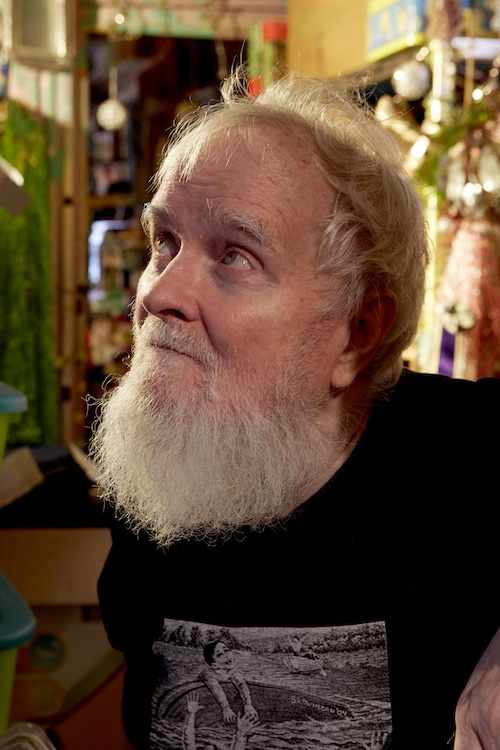
Thomas Lanigan-Schmidt was born in 1948 in Elizabeth, New Jersey. In the mid-1960s he attended Pratt Institute, then later studied at the School of the Visual Arts. In 1969, Lanigan-Schmidt participated in the Stonewall uprising in New York’s Greenwich Village, a landmark event in LGBTQ+ liberation and rights. For over 50 years the artist has exhibited his work nationally and internationally, including presentation at the 1984 Venice Biennale, 1991 Whitney Biennial, and in 1995 at the Berkeley Art Museum and Pacific Film Archive in the exhibition In a Different Light. In 2013, Lanigan-Schmidt had a retrospective exhibition at MoMA PS1. The artist lives in New York.
Lanigan-Schmidt is the featured guest in the 100th episode of the Hyperallergic podcast. Listen here.
Portrait of Thomas Lanigan-Schmidt in his NYC apartment, 2019
Photo by Jason Wyche; Art Direction by Ted Riederer
Courtesy of Howl! Happening and Pavel Zoubok Fine Art, NY
About the Work
The work of Thomas Lanigan-Schmidt, the senior member of this group, draws directly from the rituals of Roman Catholicism and reflects both the formal public worship of the Church (known as liturgy) and the individual devotional practices that have flourished over the centuries. The artist crafts chalices and other ritual objects from tin foil, cellophane, plastic jewels, pipe cleaners, and ephemera. Lanigan-Schmidt’s artworks live somewhere between devotional paraphernalia and embodiments of kitsch (that is, work that is perceived to be garish or overly sentimental). It is fitting that the chalices are displayed on altars that were formerly used for celebrating Mass.
As he shares in the following video, Lanigan-Schmidt’s fascination with liturgy and its trappings are rooted in his childhood and serving as an altar boy at his Catholic parish. Yet he was also influenced by his mother’s collection of “knick-knacks.”
Take a tour of the artist’s studio.
Watch a lecture by Lanigan-Schmidt given at the School of Visual Arts in 2013.
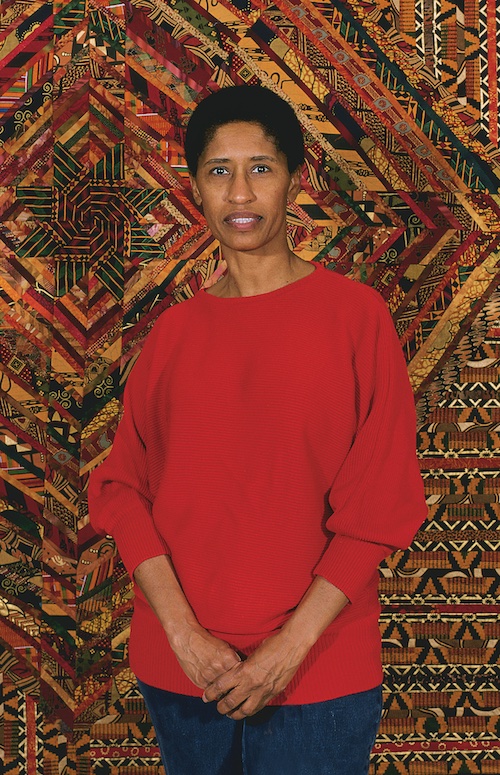
Gwendolyn A. Magee (1943–2011) was born in High Point, North Carolina, and died in Jackson, Mississippi. She received a Bachelor of Arts from the Woman’s College of the University of North Carolina (now the University of North Carolina at Greensboro), followed by graduate studies at Kent State and Washington universities. Her art has been exhibited internationally and was the subject of a survey exhibition in 2004 at the Mississippi Museum of Art in Jackson. She was selected by the Mississippi Institute of Arts and Letters as visual artist of the year in 2003 and received a Mississippi Governor’s Arts Award in 2011. Photo of the artist © Roland L. Freeman
Gwendolyn A. Magee’s abstract and narrative quilts are well regarded for their depictions of African American history and culture. Social justice and civil rights were at the heart of the artist’s approach to quilt-making, and she used this traditional folk-art form to deliver her message to individuals in the art world as well as those far from it. From 2000 through 2004 Magee worked on a series of quilts inspired by the lyrics of the iconic song “Lift Every Voice and Sing,” historically known as “the Black national anthem.” Two quilts from that series are included in the present exhibition.
- We encourage you to read “Lift Every Voice and Sing: The Quilts of Gwendolyn Ann Magee,” by Dorothy Moye, for a detailed discussion of Magee’s life, artistic practice, and quilts.
- The full text of the song “Lift Every Voice and Sing” is found below.
Magee recalled, “I grew up with this song. It’s been a major part of my life. All the way through school, we would sing it in assemblies, and sometimes daily in some of my classes. I can remember from about the age of four going with my mother to community programs or events and hearing it. For me, it’s a powerfully emotional song, because it deals with pride, cultural heritage, and a clear recognition of all the difficulties African Americans have faced over the centuries.”
Magee experienced these dynamics personally when she entered college at the University of North Carolina in Greensboro in 1959, three years after the school had been desegregated. The school was not fully integrated, though, and she and her four freshmen cohorts were segregated in their dormitory and faced discrimination. Greensboro was a center of civil rights activities during her time there, including the Woolworth’s sit-ins, and Magee participated in efforts to integrate local businesses near campus.
The quilt Full of the Faith references the first stanza of the song, which reads in part:
Sing a song full of the faith that the dark past has taught us,
Sing a song full of the hope that the present has brought us;
Facing the rising sun of our new day begun,
Let us march on till victory is won.
Faith is central in African American culture. In this work, the three silhouetted figures represent a young woman, a mature woman and an older woman. The three generations kneel together in the protective shadow of the Cross, which has been rendered in African-patterned fabric. The women are surrounded by Magee’s characteristic spirals and the Cross rises from intricately embroidered and texturally dimensional billows of smoke. The vibrant reds and gold recall the imagery of a much darker form of burning cross all too familiar in African American history.
The quilt God of Our Weary Years references the third stanza, which reads in part:
God of our weary years,
God of our silent tears,
Thou who hast brought us thus far on the way;
Thou who hast by Thy might,
Led us into the light,
Keep us forever in the path, we pray.
The incarcerated young man depicted here also appears in another quilt, not in the present exhibition, titled “Full of the Hope.”
Magee soberly reflected, “As African Americans, just as we have so much hope for our youth to ‘lead the way’ and to ‘fulfill the dream,’ we also have to daily face the reality that for countless reasons many of our youth, particularly if they are male and teenagers, somehow wind up being touched by the criminal justice system. This piece speaks to that issue.”
In 2009, Magee wrote, “I am fully aware, that the dissonance is palpable between this medium through which my art finds expression and the subject matter that it articulates. I know that the quilt form usually is associated with feelings of warmth, comfort, serenity and security and that my subject matter often is harsh, intense, somber and frequently brutal. However, viewers of the art frequently convey to me that they find the work to be compelling, evocative, meaningful and riveting.”
The lyricist of the song “Lift Every Voice and Sing,” James Weldon Johnson, recalled that
"A group of young men in Jacksonville, Florida, arranged to celebrate Lincoln’s birthday in 1900. My brother, J. Rosamond Johnson, and I decided to write a song to be sung at the exercises. I wrote the words and he wrote the music. Our New York publisher, Edward B. Marks, made mimeographed copies for us, and the song was taught to and sung by a chorus of five hundred colored school children. Shortly afterwards my brother and I moved away from Jacksonville to New York, and the song passed out of our minds. But the school children of Jacksonville kept singing it; they went off to other schools and sang it; they became teachers and taught it to other children. Within twenty years it was being sung over the South and in some other parts of the country."
Lift Every Voice and Sing
James Weldon Johnson
Lift every voice and sing
Till earth and heaven ring,
Ring with the harmonies of Liberty;
Let our rejoicing rise
High as the listening skies,
Let it resound loud as the rolling sea.
Sing a song full of the faith that the dark past has taught us,
Sing a song full of the hope that the present has brought us,
Facing the rising sun of our new day begun
Let us march on till victory is won.
Stony the road we trod,
Bitter the chastening rod,
Felt in the days when hope unborn had died;
Yet with a steady beat,
Have not our weary feet
Come to the place for which our fathers sighed?
We have come over a way that with tears has been watered,
We have come, treading our path through the blood of the slaughtered,
Out from the gloomy past,
Till now we stand at last
Where the white gleam of our bright star is cast.
God of our weary years,
God of our silent tears,
Thou who has brought us thus far on the way;
Thou who has by Thy might Led us into the light,
Keep us forever in the path, we pray.
Lest our feet stray from the places, our God, where we met Thee,
Lest, our hearts drunk with the wine of the world, we forget Thee;
Shadowed beneath Thy hand,
May we forever stand.
True to our God,
True to our native land.
See the Winston-Salem State University Choir perform “Lift Every Voice and Sing,” arranged and conducted by Dr. Roland M. Carter.
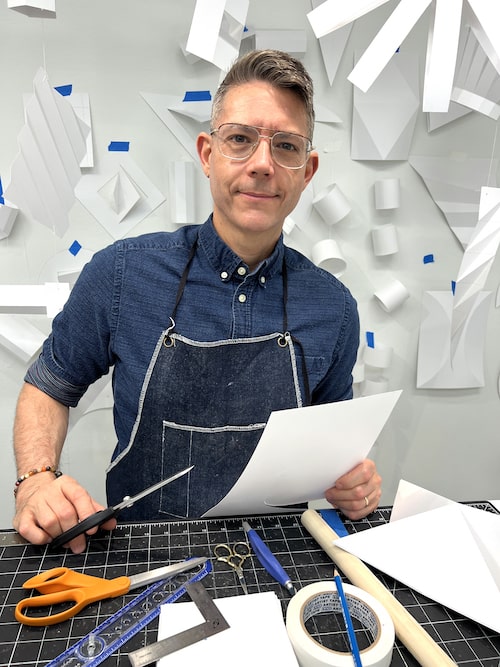
Michael Velliquette was born in 1971 in Sandusky, Ohio. He received a Bachelor of Fine Arts degree from Florida State University in 1993, and a Master of Fine Arts degree from the University of Wisconsin-Madison in 2000. A working artist for over 20 years, his work has been included in over 150 exhibitions worldwide. The artist has participated in residencies and cultural exchange programs including those at Artpace in San Antonio and the John Michael Kohler Arts Center Arts/Industry program in Sheboygan, Wisconsin. Examples of Velliquette’s art can be found in collections including the Chazen Museum of Art, the Art Museum of South Texas and Microsoft. He lives in Madison, Wisconsin. Photo courtesy of the artist
About the Work
Michael Velliquette creates exquisite, meticulously crafted paper sculptures that transform meditative practice into three-dimensional form. Heightened color and detailed imagery are hallmarks of Velliquette’s art, and his working process relies on hours of quiet contemplation. The works’ intricate designs draw inspiration from surface embellishment and architecture, while each sculpture employs a monochrome palette that removes it from the real world. For his enigmatic titles, the artist draws on a variety of sources, including poetry, philosophy, and theology.
All of the paper used in Velliquette’s sculptures is hand cut with straight edge scissors or X-Acto knives. On average each paper sculpture takes between 300 to 500 hours, and he produces about three to four works per year. Velliquette shares that this body of work developed as he was cultivating a disciplined meditation practice. “Throughout this period my work became increasingly abstract and, for me, the process of making the work became a kind contemplative exercise — keeping my mind present and concentrated on the cutting, gluing and arranging each piece of paper. I began to think of them as kind of three-dimensional mandalas of sorts.”
The titles of the works are drawn from poets and teachers whose writings have influenced Velliquette. Now heaven's river drowns its banks, and floods of joy have run abroad and and Our newly awakened powers cry out for unlimited fulfillment are titled from excerpts of work by the Indian mystical poet Rabindranath Tagore.
The fullness of experience and The direct path draw their titles from the teachings of Rupert Spira on Non-Dualism, which Spira describes as
"... the recognition that underlying the multiplicity and diversity of experience there is a single, infinite and indivisible reality, whose nature is pure consciousness, from which all objects and selves derive their apparently independent existence. The recognition of this reality is not only the source of lasting happiness within all people; it is the foundation of peace between individuals, communities and nations, and it must be the basis for any sustainable relationship with the environment."
Velliquette says of his art, “It’s very slow and deliberate work, it’s about concentration and awareness. They are contemplative objects in the sense I intend for viewers to lose themselves in the experience of looking at them.”
Velliquette discusses his practice on the podcast “Cut It Out!”
